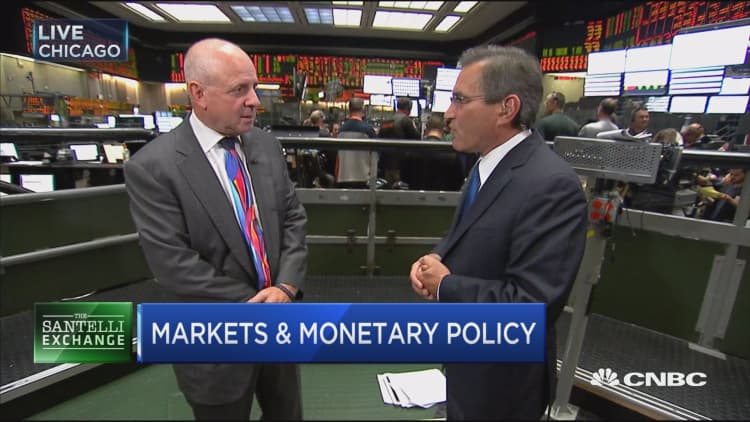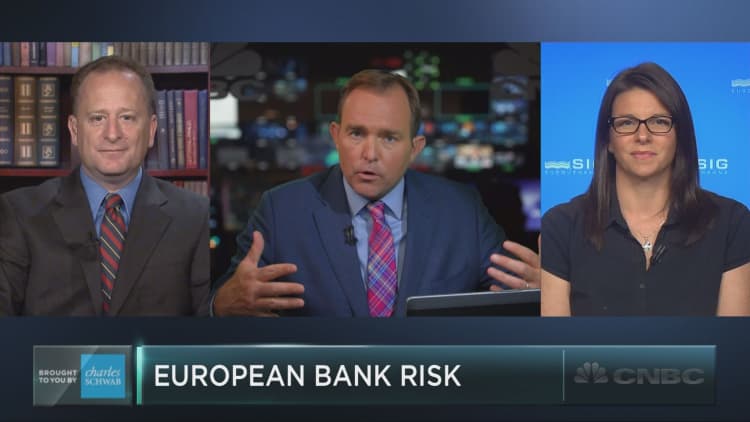
Any chance the Federal Reserve had of raising rates this year may have been quashed Thursday, with the impetus coming not from home but from the other side of the Atlantic.
The Bank of England's decision to not only cut interest rates but to restart its money-printing program makes the corner in which the Fed had found itself even more claustrophobic.
That's because the U.S. central bank will find it even harder to tighten monetary policy as one of its closest peers loosens.
"Given the role of the Fed and its global positioning with regard to the dollar, can it be the one central bank that starts to raise rates?" asked Quincy Krosby, market strategist at Prudential Financial. "It's highly unlikely, given their focus on keeping the U.S. dollar in a range."
The dollar is down about 3 percent this year against its global peers, but Fed officials worry that raising interest rates will strengthen the greenback and make financial conditions tighter.
The interconnected nature of the global economy has unequivocally spread to monetary policy. Central banks around the world have been racing to ease in hopes that low and sometimes negative interest rates, coupled with asset purchases, can spur growth and keep their respective currencies weak.
Even though the results of such policies have been less than overwhelming, the BOE's actions serve as a reminder that there's still no end in sight, and central banks will use every weapon they can muster.
"We've moved into the new frontier of monetary policy. Thus far it doesn't look successful, because they have to keep pushing," Krosby added. "It has the air of desperation."
After nearly a decade of extraordinarily loose policy, the Fed has been looking to begin what is likely to be a long and gradual normalization process.
Under other conditions, the bank might even be able to use the loose policy of other central banks as cover to continue on the path begun in December — the thinking there being that nobody's counting on the Fed to keep global financial conditions loose, because so many other economies are doing it. The Federal Open Market Committee at December's meeting approved its first hike in more than nine years — a quarter point — and officials indicated that four more would be on the way in 2016.
However, the Fed's problem is the slow-moving economy, and that plan to raise rates steadily has been abandoned. U.S. growth averaged just 1 percent in the first half of 2016, and an expected second-half pickup may not be enough to justify tightening. Investors don't seem to mind, as stocks continue to climb, but worries grow that all the central bank actions will have negative consequences later.
"It's not about what the other central banks are doing, it's about the U.S. economy. I think we're back in recession. If not, we're so close to it," said Peter Schiff, founder of Euro Pacific Capital and frequent Fed critic.
"The Fed is just trying to maintain the false narrative of success and recovery," he added. "They're reluctant to acknowledge how weak the economy is, so they want to pretend they're considering rate hikes."

Rising doubts about the US economy
While most on Wall Street aren't expecting a recession, the doubts about the economy are strengthening. Deutsche Bank chief U.S. economist Joseph LaVorgna has said the economy would be in recession without an unusual, and perhaps unsustainable, boost from consumer spending, while Bank of America Merrill Lynch on Thursday increased its 2016 GDP forecast — to only 1.5 percent.
Fed officials publicly are professing that hiking rates is still an option in 2016. But the markets aren't buying it anymore.
In fact, the CME's FedWatch tracker looks all the way out to July 2017 and sees only a 41.4 percent chance of a rate hike by then. Individual fed funds futures contracts going out to July 2018 see the central bank's overnight rate at just 0.55 percent, or 0.15 percentage points higher than the current level.
Rate-hike chances declined Thursday following the BOE decision. The latest developments are rekindling frustration on Wall Street that central banks continue to believe they can save the world, even though the evidence is to the contrary.
BOE Governor Mark Carney "today has proven that he is just the same as the others in believing too highly of the abilities of central banks to generate economic growth and showing no sense of humility about their effectiveness," Peter Boockvar, chief market analyst at The Lindsey Group, said in a note. "Creating asset bubbles is their only real skill set."
Correction: An earlier version had the wrong title for Bank of England Governor Mark Carney.


